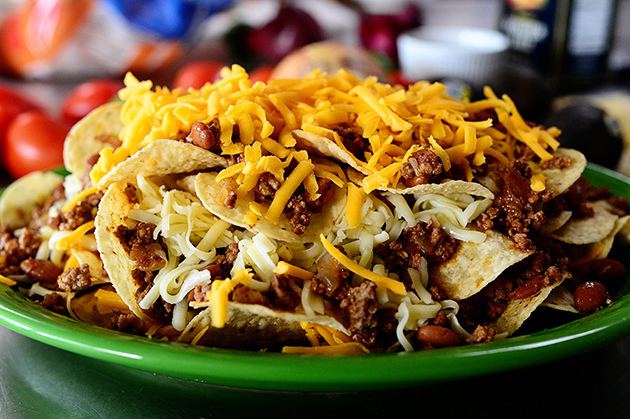Region or state Coahuila Serving temperature Warm | Created by Ignacio Anaya Main ingredients Tortilla chips | |
 | ||
Similar Taco, Guacamole, Wheat tortilla, Burrito, Quesadilla | ||
Nachos best classic recipe
Nachos are a snack food dish from northern Mexico. The dish is composed of tortilla chips and melted cheese, and is often served as a snack. More elaborate versions add more ingredients and can be served as a main dish, for example ground meat and sliced jalapeño peppers.
Contents
- Nachos best classic recipe
- The ultimate nachos recipes
- History
- Variations
- Ingredients
- Nacho cheese
- References

The ultimate nachos recipes
History

Nachos originated in the city of Piedras Negras, Coahuila, Mexico, just over the border from Eagle Pass, Texas. In 1943, the wives of U.S. soldiers stationed at Fort Duncan in nearby Eagle Pass were in Piedras Negras on a shopping trip, and arrived at the restaurant after it had already closed for the day. The maître d'hôtel, Ignacio "Nacho" Anaya, invented a new snack for them with what little he had available in the kitchen: tortillas and cheese. Anaya cut the tortillas into triangles, fried them, added shredded cheddar cheese, quickly heated them, added sliced pickled jalapeño peppers,[Note 1] and served them.
When asked what the dish was called, he answered, "Nacho's especiales". As word of the dish traveled, the apostrophe was lost, and Nacho's "specials" became "special nachos".

Anaya went on to work at the Moderno Restaurant in Piedras Negras, which still uses the original recipe. He also opened his own restaurant, "Nacho's Restaurant", in Piedras Negras. Anaya's original recipe was printed in the 1954 St. Anne's Cookbook.
The popularity of the dish swiftly spread throughout Texas and the Southwest. The first known appearance of the word "nachos" in English dates to 1950, from the book A Taste of Texas. According to El Cholo restaurant history, waitress Carmen Rocha is credited with making nachos in San Antonio, Texas, before introducing the dish to Los Angeles at El Cholo Mexican restaurant in 1959.
A modified version of the dish, with cheese sauce and prepared tortilla chips, was marketed in 1976 by Frank Liberto, owner of Ricos Products, during sporting events at Arlington Stadium in Arlington, Texas. This version became known as "ballpark nachos". During a Monday Night Football game, sportscaster Howard Cosell enjoyed the name "nachos", and made a point of mentioning the dish in his broadcasts over the following weeks, further popularizing it and introducing it to a whole new audience.
Ignacio Anaya died in 1975. In his honor, a bronze plaque was erected in Piedras Negras, and October 21 was declared the International Day of the Nacho. Anaya's son, Ignacio Anaya, Jr., served as a judge at the annual nacho competition until his death in 2010.
The International Nacho Festival is held between October 13 and 15 at Piedras Negras and features a "biggest nacho of the world" contest which is registered with the Guinness World Records.
Variations
A variation consists of a quartered and fried tostada topped with a layer of refried beans and/or various meats and a layer of shredded cheese or nacho cheese, topped with habanero hot sauce.
Other variations include barbecue nachos (replace cheese with barbecue sauce) and poutine nachos (replace cheese with gravy). Although nontraditional, these versions are still classified as nachos.
Ingredients
Common toppings include:
See also the common cheeses used:
Nachos with an abundance of toppings are sometimes called "loaded nachos" or "super nachos". This type of dish is usually served as an appetizer at bars or restaurants in the United States and elsewhere, though they generally tend to be as sizable as a meal. Typically, the tortilla chips are arranged on a platter, meat and refried bean toppings are then added, and the entire platter is smothered with shredded cheese. The platter is then put into a broiler or microwave to cause the cheese to melt. The platter is then covered with the cold toppings (shredded lettuce, tomatoes, salsa, jalapeños, etc.) and served immediately.
In Memphis, Tennessee, barbecue nachos are served in most barbecue restaurants, and also at sporting events. Generous portions of barbecued pork shoulder are placed atop tortilla chips, then covered with melted cheese or nacho cheese, barbecue sauce, and sliced jalapeño peppers.
In Hawaii, kalua pork and pineapple nachos are served in many restaurants and bars. Generous portions of kalua pork and pineapple bits are placed atop tortilla chips, then covered with melted cheese or nacho cheese, and varied toppings.
A similar dish that involves tortilla chips and cheese is found in Tex-Mex restaurants. Small bowls of chili con queso and/or, more commonly, salsa, are served with baskets of warm tortilla chips as appetizers.
Nacho cheese
A form of processed cheese sauce mixed with peppers and other spices is often used in place of freshly shredded cheese in institutional or large-scale production settings, such as schools, movie theaters, sports venues, and convenience stores, or wherever using freshly grated cheese may be logistically prohibitive. Though originally formulated as a cheaper and more convenient source of cheese to top nachos, this dip has become popular enough in the U.S. that it is available in some Mexican-themed restaurants, and at major grocery stores, in both name-brand (Frito-Lay, Tostitos, and Taco Bell) and unbranded versions.
